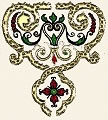|
|
 |
Female
Indoor Garments
|
 |
Once indoors,
the lady changed just like the gentleman into more comfortable garments.
She changed her heavy robes for a house-dress, her high heeled shoes
for mules and the fontange (in the latter part of the period) for
a much simpler coif or lace cap. The dress which was worn indoors
was usually shaped like a jacket, open at the front, and reached
down to the floor. The house garment, as well as the caps, were
richly decorated with lace. Again, corresponding to the dressing
gown which the man was wearing indoors, these house garments were
not only meant to be seen by family members, but were also worn
when informally receiving visitors and such. It was often touched
up by a small decorative apron.

Female
Costumes
Ladies' Baroque Clothing
Indoor
Garments | Footwear | Accessories | Hairstyles | Head-dresses | Development
of the Fontange
Hairstyles
by Vermeer | Dress
Colours by Vermeer | Head-dresses
by Vermeer
Costume Focus Headwear & Neckwear | Costume
Focus Working Women
Costume
Focus Children's Clothing
Ladies'
Costume Quotes
Male
Costumes
Gentlemen's
Baroque Clothing
Indoor
Garments | Footwear | Accessories | Hairstyles | Head-dresses
Costume
Colours by Vermeer | Hair-
and Head-dresses by Vermeer
Gentlemen's
Costume Quotes
~ ~ ~ ~ ~ ~ ~ ~ ~ ~ ~ ~ ~
Embroidery Gallery | Gallery of Needlework
Engravings
Lace Gallery &
Identification | Glossary
Contents © N. Kipar 1997 |









